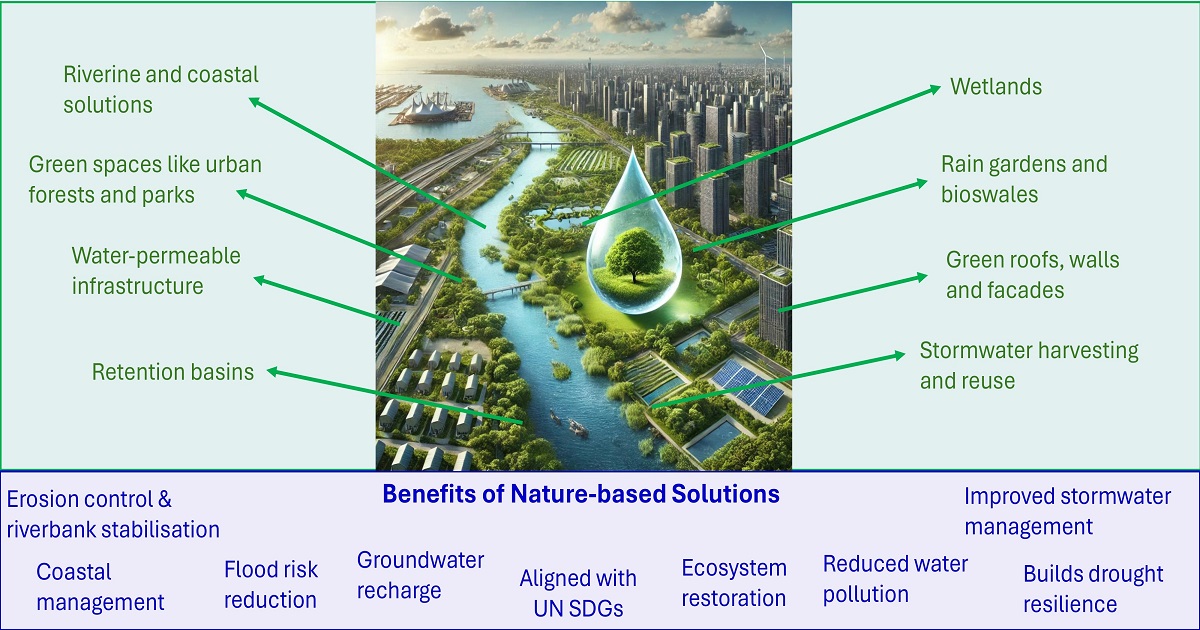Sustainable Urban Water Management: The Role of Nature-Based Solutions
A special issue of Water (ISSN 2073-4441). This special issue belongs to the section "Urban Water Management".
Deadline for manuscript submissions: 31 March 2026 | Viewed by 10457

Special Issue Editors
Interests: urban water management; resilient urban water systems; climate change mitigation; nature based solutions; sustainable and liveable cities; machine learning techniques
Special Issues, Collections and Topics in MDPI journals
Interests: watershed modeling; hydrology; urban water management; climate adaptation; AI-driven engineering solution
Special Issues, Collections and Topics in MDPI journals
Special Issue Information
Dear Colleagues,
As cities grow and climate change intensifies, the challenges of sustainable urban water management are becoming more urgent. Urban areas are vulnerable to water-related issues like flooding, droughts, and pollution, which affect both the environment and public health. Traditional water management methods, often reliant on engineered solutions, can reduce immediate risks but fail to address the interconnectedness of water, ecology, and urban resilience. Over time, these methods can be costly and environmentally harmful and are unable to meet the growing demands of expanding populations while also failing to adapt to climate change.
Recently, there has been a growing recognition of the need for more sustainable practices, such as Nature-based Solutions (NbS), in urban water management. These solutions stem from the understanding that nature holds many answers to urban water challenges. NbS offer innovative alternatives that use natural processes to manage water sustainably while providing co-benefits like enhanced biodiversity, improved public spaces, and climate resilience.
This Special Issue explores how NbS can address urban water challenges by integrating natural systems into city infrastructure. NbS, such as green roofs, permeable pavements, wetlands, urban forests, etc., help regulate water flow, improve water quality, and restore ecosystems. They also offer cost-effective, adaptive strategies to cope with climate variability, supporting long-term resilience and providing effective interventions to protect, manage, and/or restore natural or modified systems, including cities, rivers, watersheds, and coastlines. We invite original research and reviews to inspire dialogue, collaboration, and innovation across sectors, encouraging cities to adopt nature-based approaches in their water management strategies.
Dr. Nitin Muttil
Dr. Upaka Rathnayake
Guest Editors
Manuscript Submission Information
Manuscripts should be submitted online at www.mdpi.com by registering and logging in to this website. Once you are registered, click here to go to the submission form. Manuscripts can be submitted until the deadline. All submissions that pass pre-check are peer-reviewed. Accepted papers will be published continuously in the journal (as soon as accepted) and will be listed together on the special issue website. Research articles, review articles as well as short communications are invited. For planned papers, a title and short abstract (about 100 words) can be sent to the Editorial Office for announcement on this website.
Submitted manuscripts should not have been published previously, nor be under consideration for publication elsewhere (except conference proceedings papers). All manuscripts are thoroughly refereed through a single-blind peer-review process. A guide for authors and other relevant information for submission of manuscripts is available on the Instructions for Authors page. Water is an international peer-reviewed open access semimonthly journal published by MDPI.
Please visit the Instructions for Authors page before submitting a manuscript. The Article Processing Charge (APC) for publication in this open access journal is 2600 CHF (Swiss Francs). Submitted papers should be well formatted and use good English. Authors may use MDPI's English editing service prior to publication or during author revisions.
Keywords
- sustainable urban water management
- nature-based solutions
- floods and droughts
- water quality improvement
- climate resilience
- green infrastructure
- environmental sustainability
- coastal management
- liveable cities
- sustainable development goals (SDGs)
Benefits of Publishing in a Special Issue
- Ease of navigation: Grouping papers by topic helps scholars navigate broad scope journals more efficiently.
- Greater discoverability: Special Issues support the reach and impact of scientific research. Articles in Special Issues are more discoverable and cited more frequently.
- Expansion of research network: Special Issues facilitate connections among authors, fostering scientific collaborations.
- External promotion: Articles in Special Issues are often promoted through the journal's social media, increasing their visibility.
- Reprint: MDPI Books provides the opportunity to republish successful Special Issues in book format, both online and in print.
Further information on MDPI's Special Issue policies can be found here.






